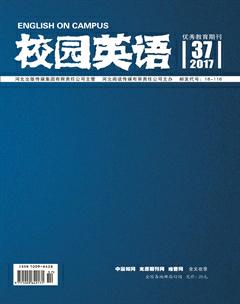A Brief Analysis of Interlanguage
She+Ali
【Abstract】This paper makes a brief analysis on the interlanguage from the from the aspect of psycholinguistics, and it is hoped to be helpfu for the English teachers.
【Key words】interlangage; psycholinguistics; transfer
1. Introduction
The method of comparing two whole languages of Constrastive Analysis (CA) yields only a partial picture of the second languaage (L2) learning. The focus should be on the learners own system as it develops closer towards the L2:“only by treating language learners language as a phenomenon to be studied in its own right can we hope to develop an understanding of the processes of second language acquisition” (Coder, 1978). As we shall see, in fact the Second Language Acquisition (SLA) research often falls back on to the easier option of comparing the learners language with the natives rather than adhering fully to the independent grammars assumption.
2. Defition of Interlanguage
“Interlanguage”, was the term introduced by Larry Selinker in 1972, and was widely accepted for the L2 learners independent language system (Cook, 2000). In other words, Interlanguage refers to the language system constructred by second language leaners on their way to the taget language. (Wang, 2009) Thats to say, the IL is a dynamic system, evolving over time. (Shen, 2009)
3. The Psycholinguistical Aspects of Interlanguage
Psycholnguistics is the study of the mental structures and processes involved in the acquisition and use of language. The study of psycholinguitic aspects of SLA has given rise to many acquisition models, such as the first language (L1) transfer, the role of consciousness, processing operations, and communication strategies.
3.1 Positive Transfer and Negative Transfer from L1
L1 transfer refers to the influence that the learners L1 exerts over the acquiisition of an L2. This influence is apparent in a number of ways. First, it is noted in error analysis, that the leamers LI is one of the sources of error in learner language. This influence is referred to as negative transfer. However, in some cases, the learners L1 can facilitate SLA. SVO syntactic structures are common in Chinese and English, so Chinese learners are much less likely to make syntactic errors than are Japanese learners. This type of effect is known as positive transfer.
3.2 The Role of Consciousness in SLA
Children seem to acquire their L1 without conscious effort. In contrast, L2 adult learners have to work hard and to study the language consciously. This comparison is not entirely accurate for L2 learners who are also capable of acquiring L2 in the same way as childrens LI A. The role of consciousness becomes one of the most controversial issues in SLA. Irrespective of whether learners learn implicitly or explicitly, it is widely accepted that they can acquire different kinds of knowledge. It is perhaps self-evident that all language users, including L2 learners, know rules that guide their performance without any awareness of what the rules consist of.
3.3 Communication stragegies
A look should be necessarily taken at the mechanisms involved when learners use their qcquired L2 knowledge in communication. As L2 learners who have tried to communicate know, they frequently experience problems in saying what they want to say because of their inadequate L2 knowledge. In order to overcome these problems they resort to various kinds of communication strategies. If learners do not know a word in L2 they may “borrow” a word from their LI or use another L2 word that is approximate in meaning (for example, uwormn for usilkwormn), or try to paraphrase the meaning of the word, or even construct an entirely new word (for example, “picture place” for “art gallery”). There have been a number of attempts to construct psycholinguistic models to account for the use of communication strategies.
4. Conclusion
What all the theories and approaches to Interlanguage have in common is that they apply models of input processing and LI transfer to the SLA context. They do not generally have a great deal to say about the linguistic system that learners are constructing. Whatever, the Interlanguage moved one step beyond Error Analysis, by focusing on the learner system, rather than only on its errors.
References:
[1]Corder S P.Language-learner Language[A].In J.C.Richards (ed.).Understanding Second and Foreign Language Learning: Issues and Approaches[C].Rowley,Mass:Newbury House.1978.
[2]Cook V.Linguistics and Second language Acquisition[M].Beijing:Foreign Language Teaching and Research Press.Macmillan Publishers Ltd,2000.
[3]沈昌洪,劉喜文,季忠民.Second Language Acquisition:An Introductory Course[M].Beijing:Peking University press,2010.

